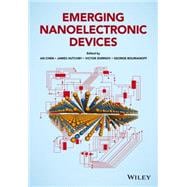Emerging Nanoelectronic Devices focuses on the future direction of semiconductor and emerging nanoscale device technology. As the dimensional scaling of CMOS approaches its limits, alternate information processing devices and microarchitectures are being explored to sustain increasing functionality at decreasing cost into the indefinite future. This is driving new paradigms of information processing enabled by innovative new devices, circuits, and architectures, necessary to support an increasingly interconnected world through a rapidly evolving internet. This original title provides a fresh perspective on emerging research devices in 26 up to date chapters written by the leading researchers in their respective areas. It supplements and extends the work performed by the Emerging Research Devices working group of the International Technology Roadmap for Semiconductors (ITRS).
Key features:
• Serves as an authoritative tutorial on innovative devices and architectures that populate the dynamic world of “Beyond CMOS” technologies.
• Provides a realistic assessment of the strengths, weaknesses and key unknowns associated with each technology.
• Suggests guidelines for the directions of future development of each technology.
• Emphasizes physical concepts over mathematical development.
• Provides an essential resource for students, researchers and practicing engineers.








